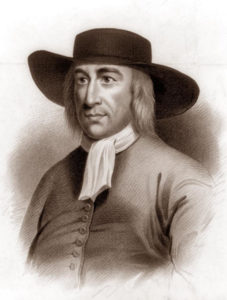Who Was George Fox?

Born and raised in a deeply Puritan community, George Fox (1624-1691) became a prominent “dissenting” minister in the midst of the English Civil War of the 1640s. Fueled by a dissatisfaction with the corrupt religious and political authorities within the Church of England, George Fox advocated for a simpler life aligned with strict adherence to an uncompromising Christian faith. Focusing on the power and presence of the Holy Spirit within believers, called the Inward Light, Fox highlighted personal experience and spiritual conversion above religious rituals. Under this belief, women and even children have the right of ministry through the power of the Holy Spirit.
His beliefs, practices, and followers soon became known as the Religious Society of Friends, or more commonly, as Friends or Quakers. Friends came under extreme criticism and persecution in England until the Toleration Act of 1689. This act allowed Friends limited religious freedom. Quakerism soon spread throughout England and into the United States, and by 1700 had almost 100,000 followers.
Theology Today
George Fox called Christians to live an authentic faith and to quit the outward sacraments of communion and water baptism. Instead, Friends practice the sacraments inwardly through a personal, spiritual relationship with God. Friends also practice silence as a key part of their worship meetings. According to Friends, this silence, or “open worship”, provides the space for God to speak to each Christian directly, and not just through a pastor. Friends do not ordain ministers, believing that God has already ordained them by spiritual calling.
Distinct values of Friends include: a commitment to simplicity, integrity, and equality. Traditionally, Friends have been a pacifist denomination and are known for conscientious objection and anti-war protest. While not all Friends today are pacifists, most are still committed to non-violent peacemaking as the primary form of conflict resolution.